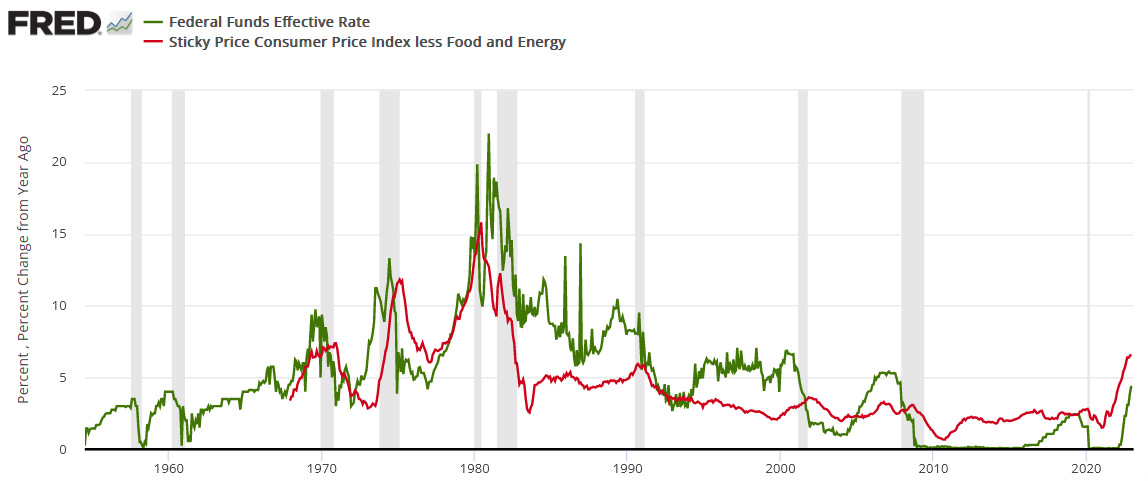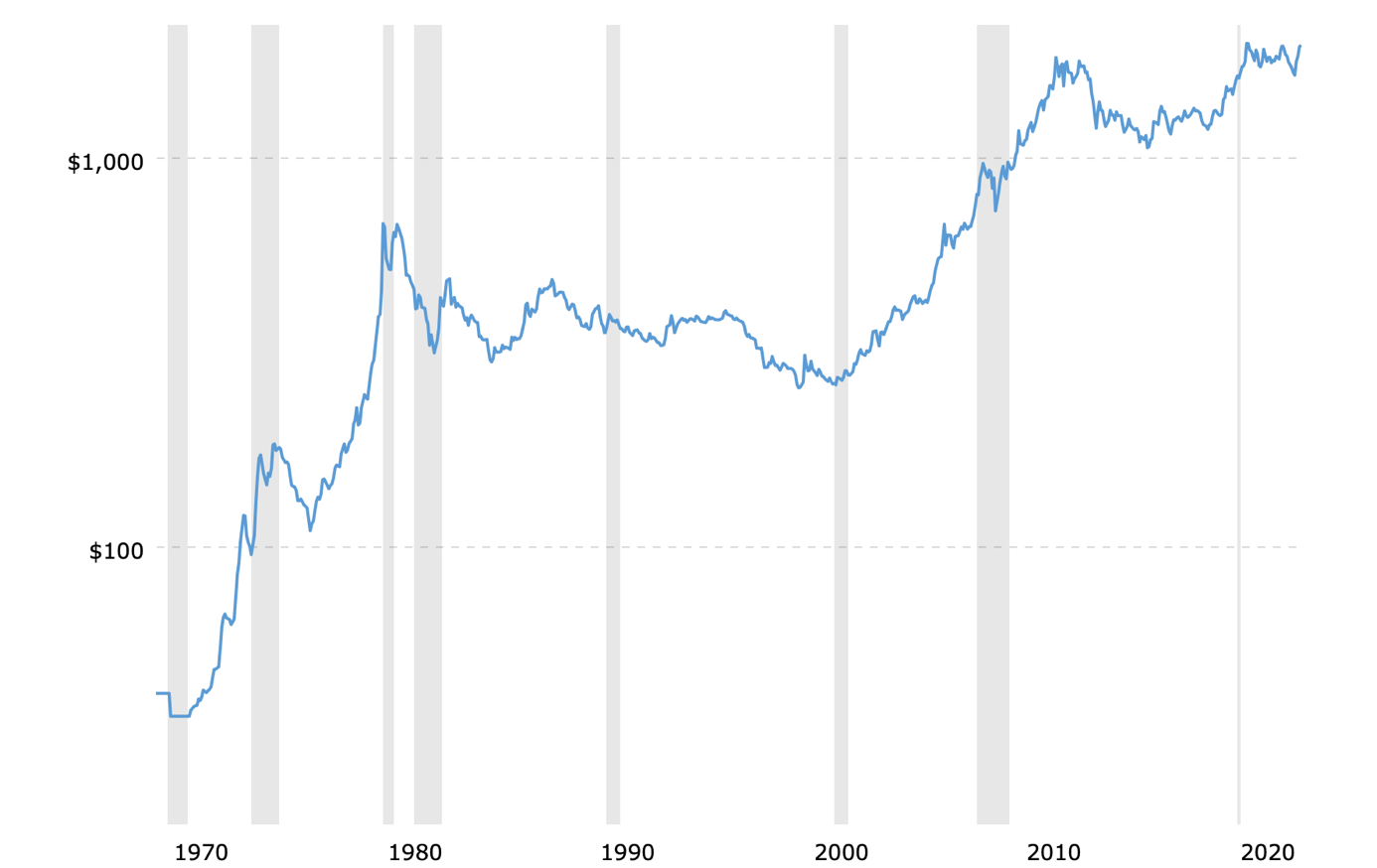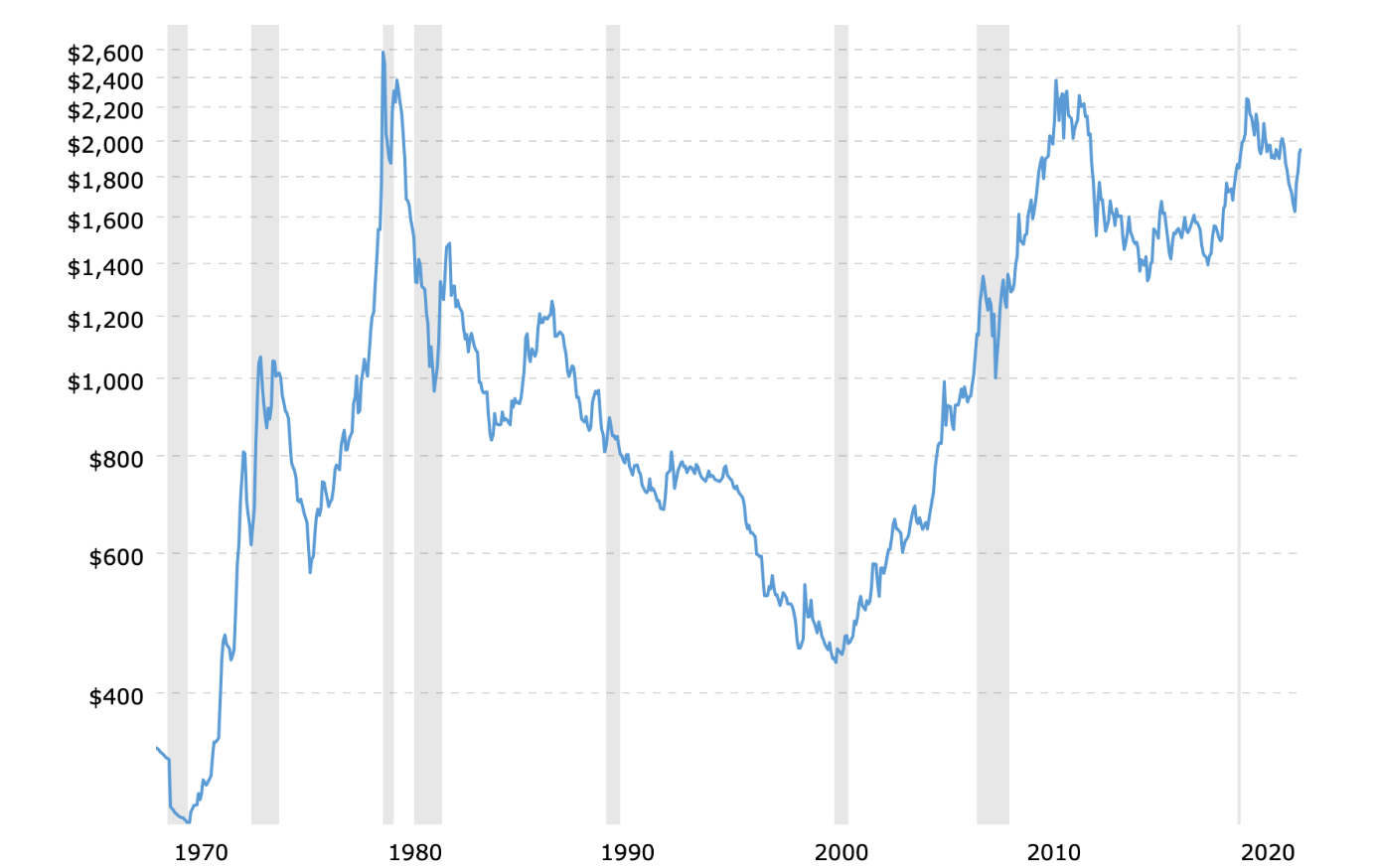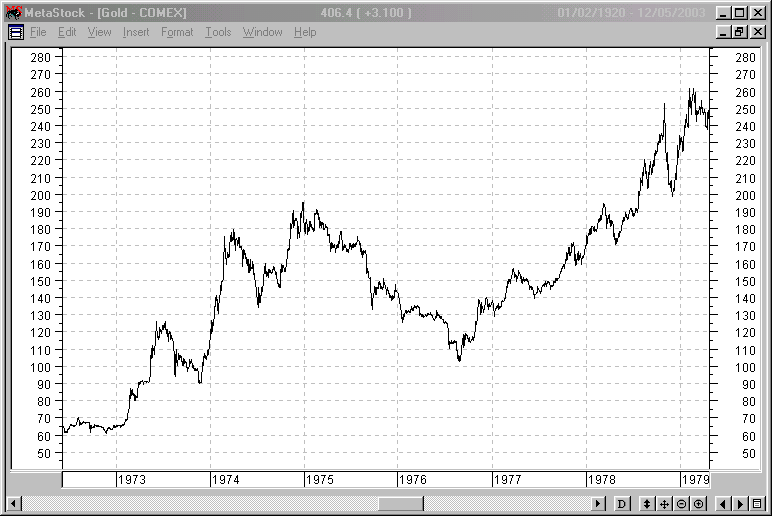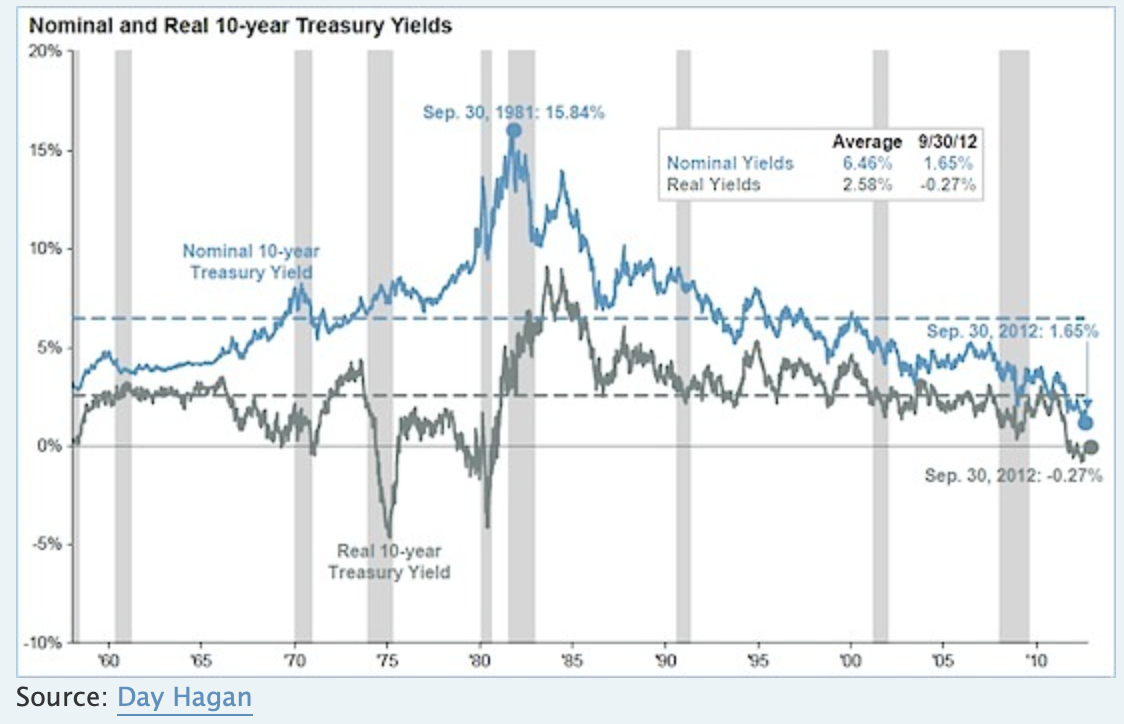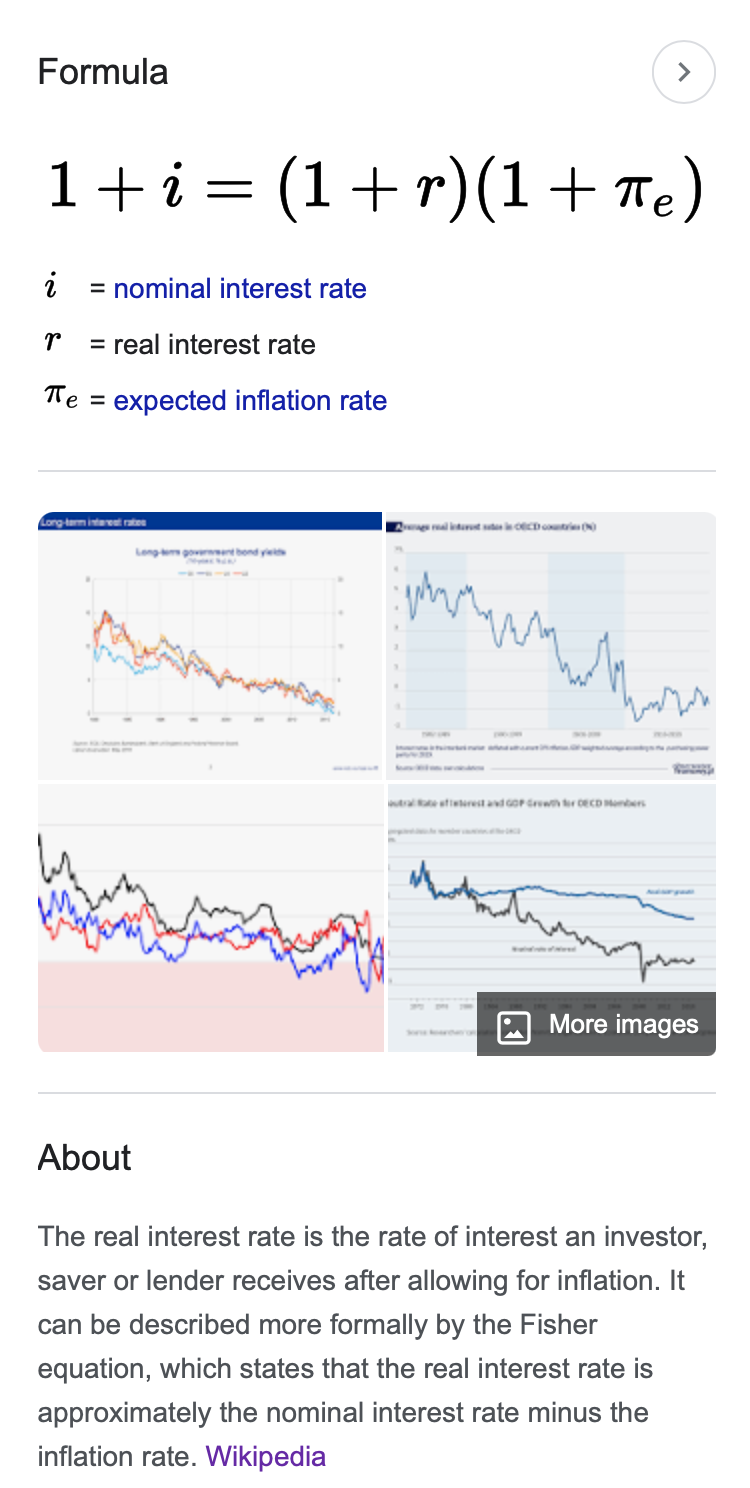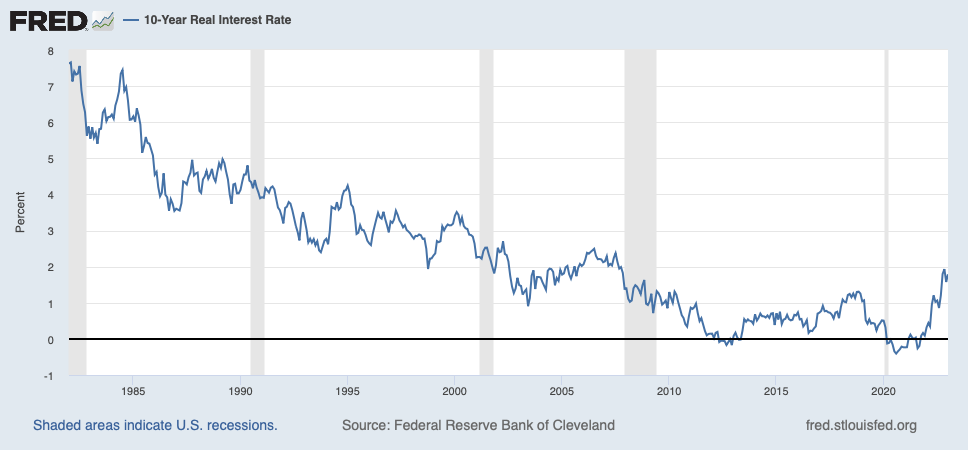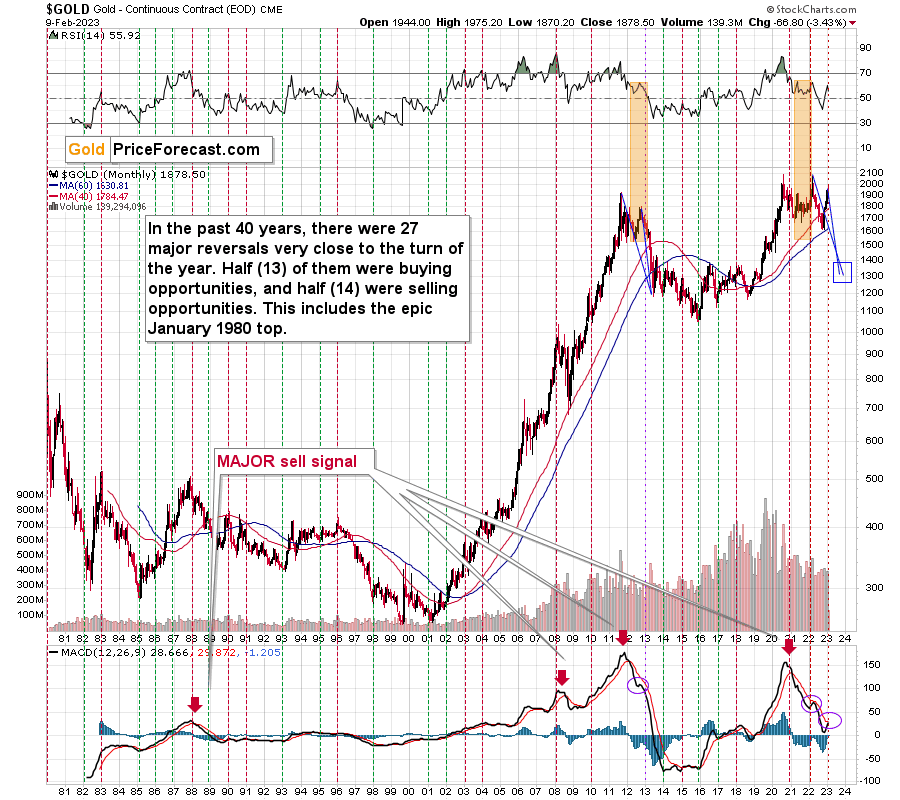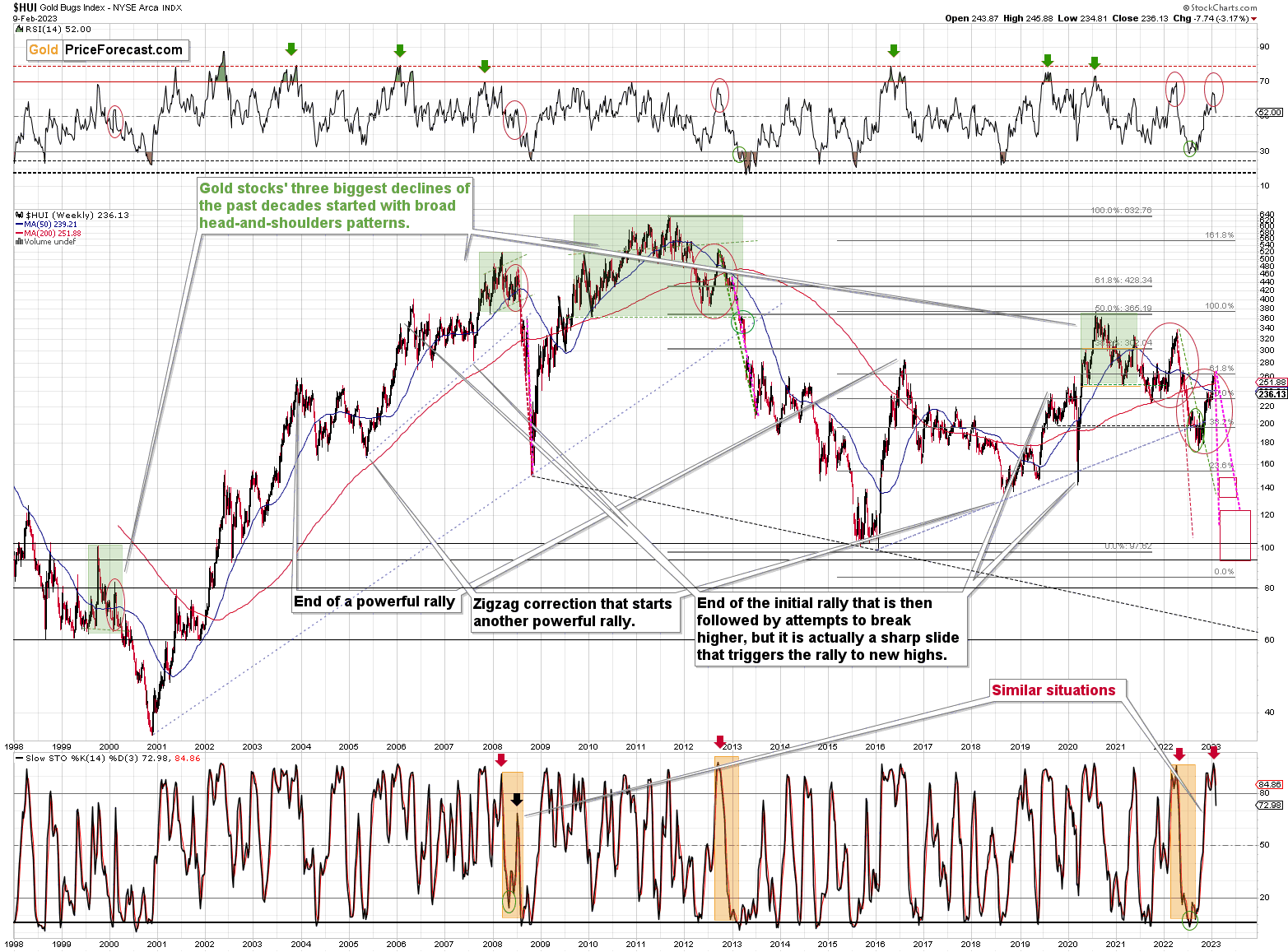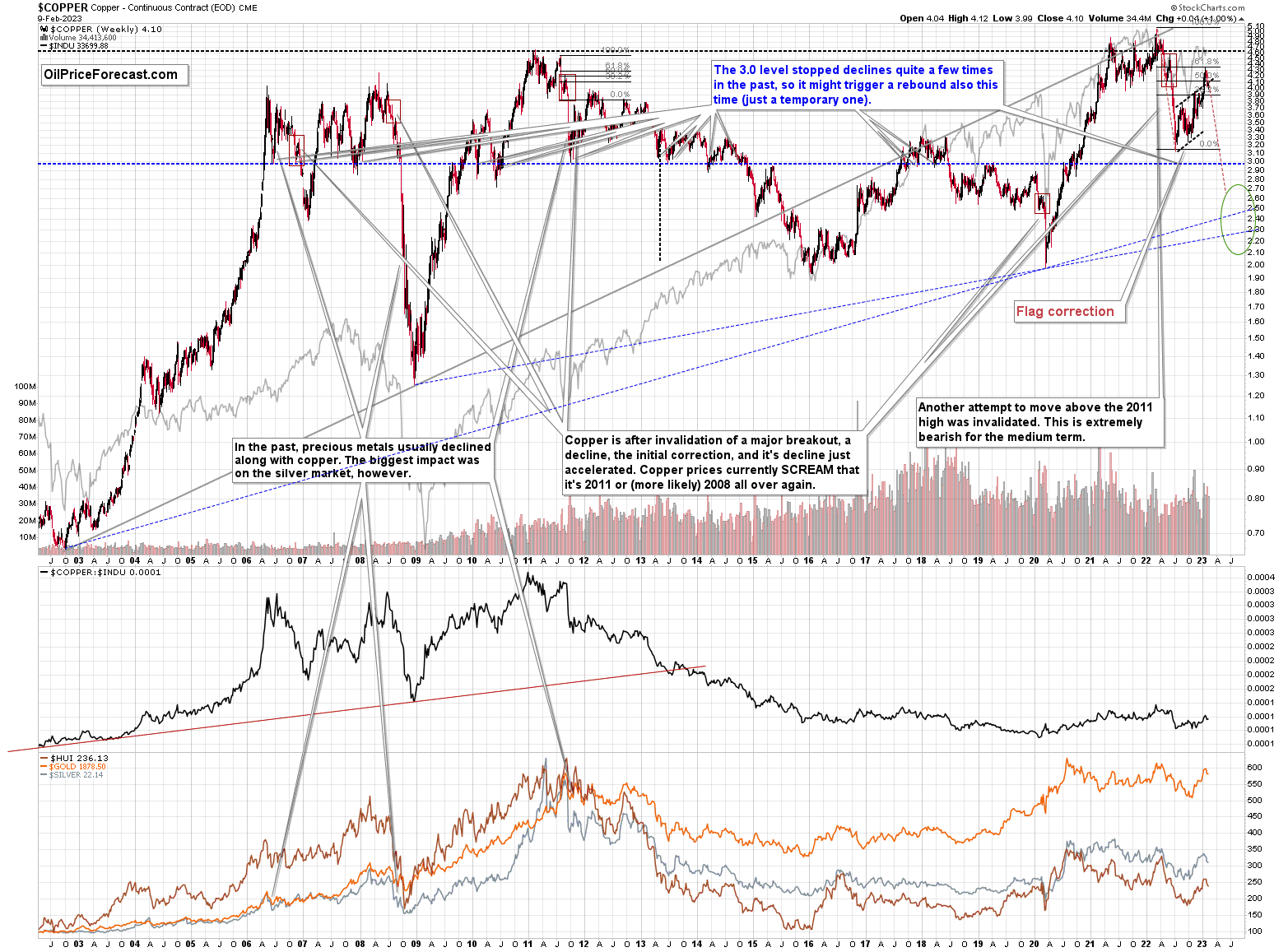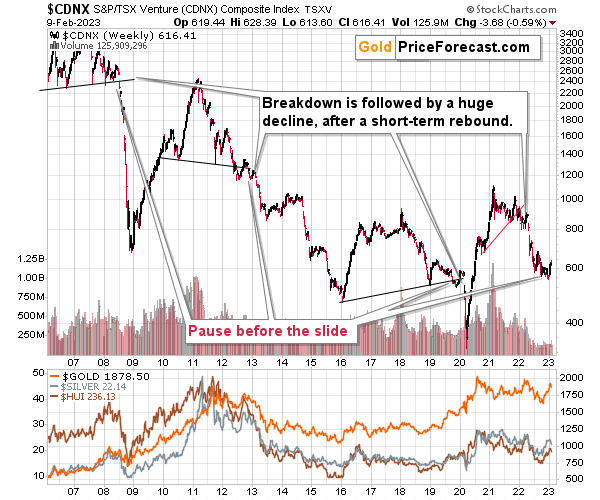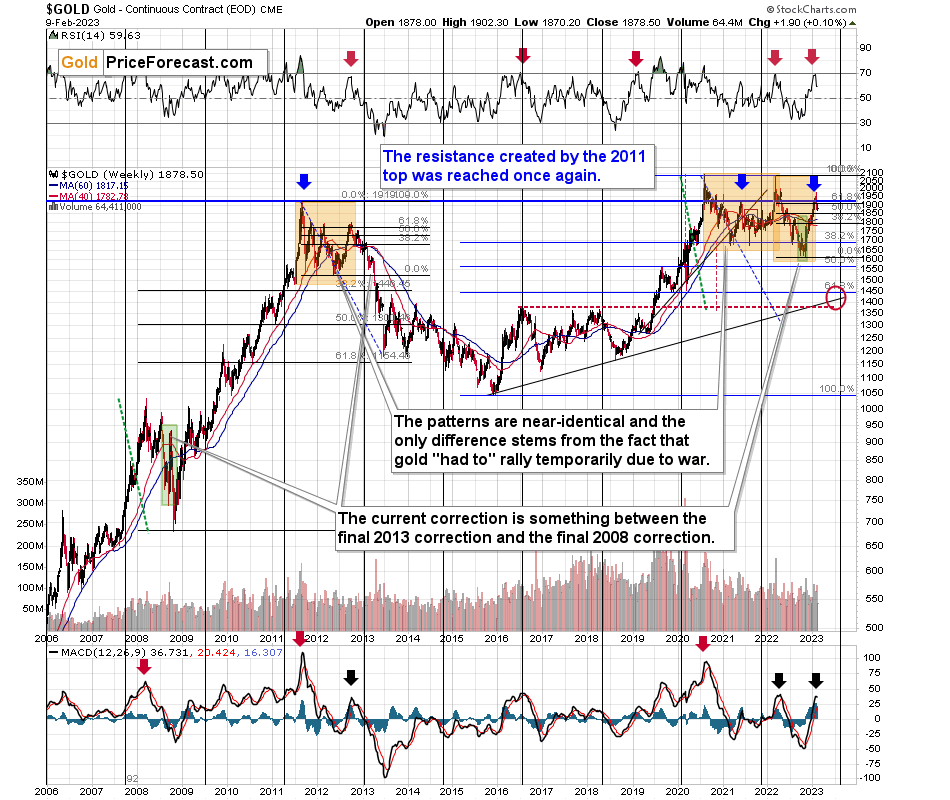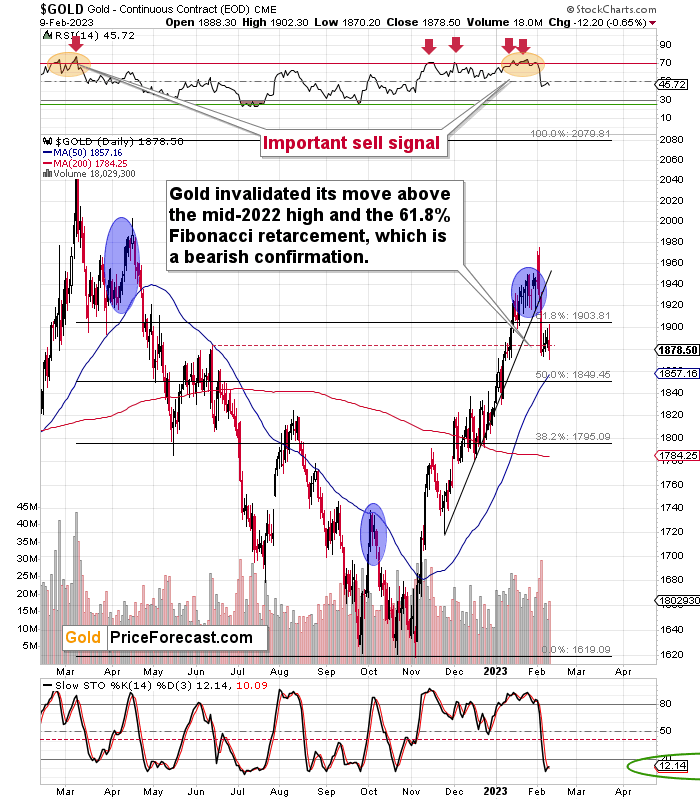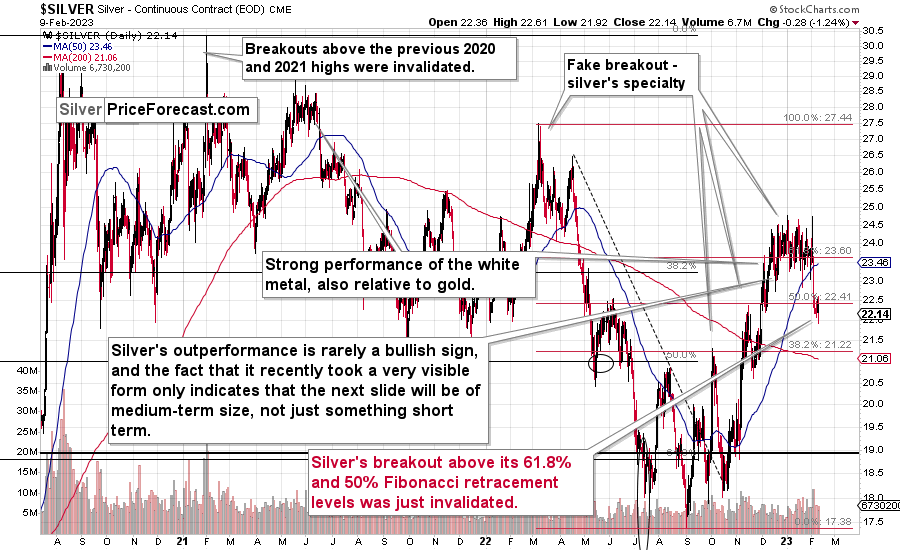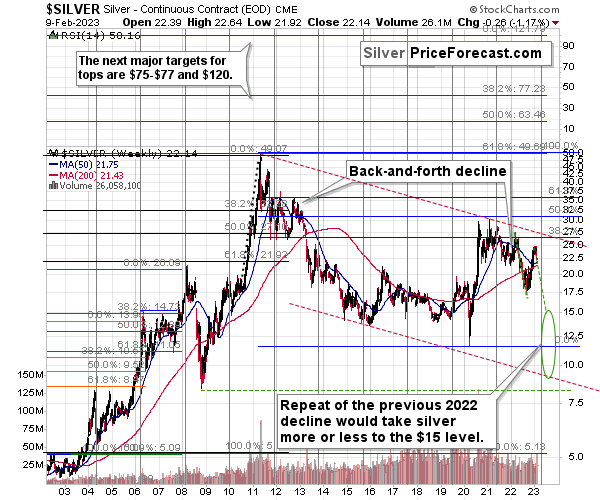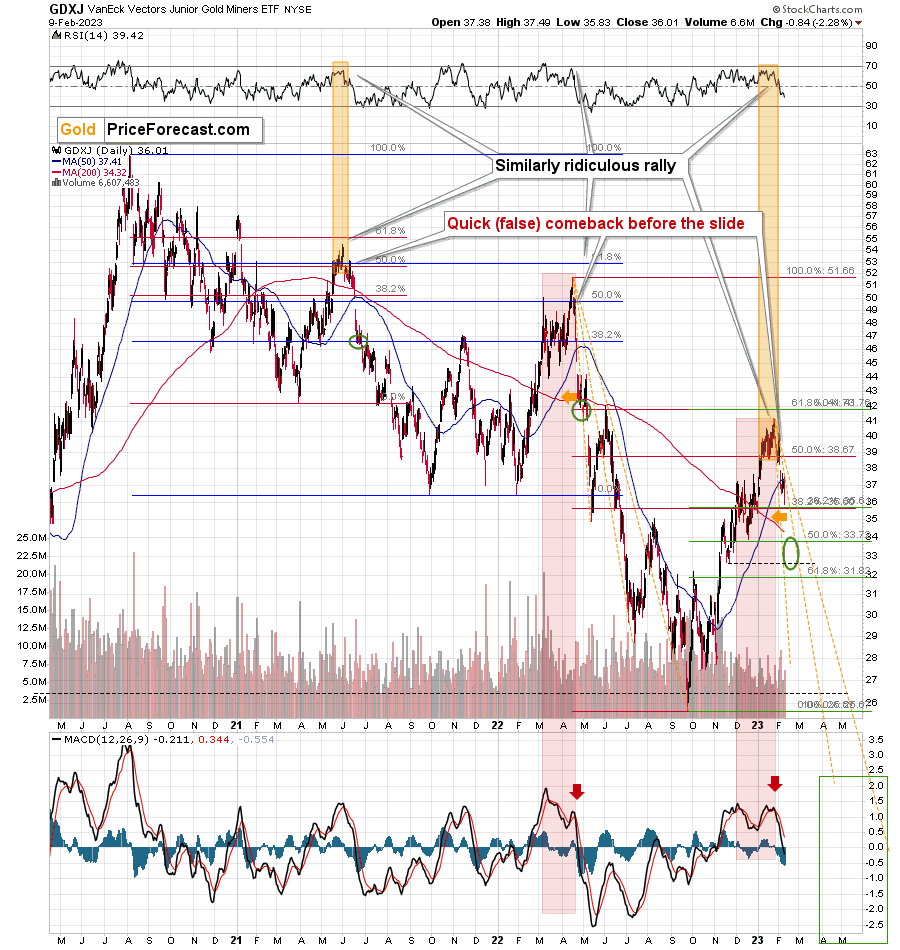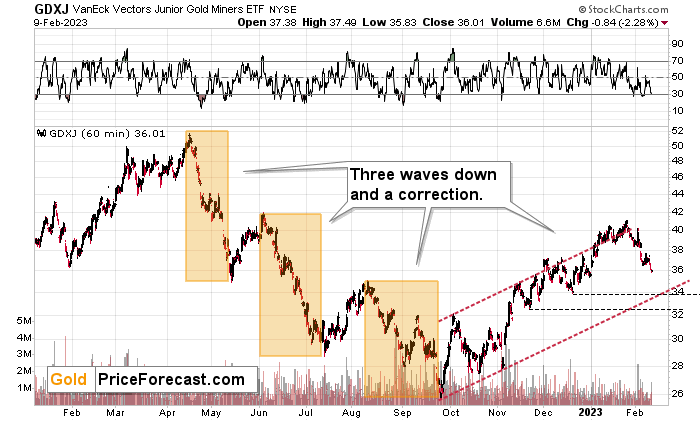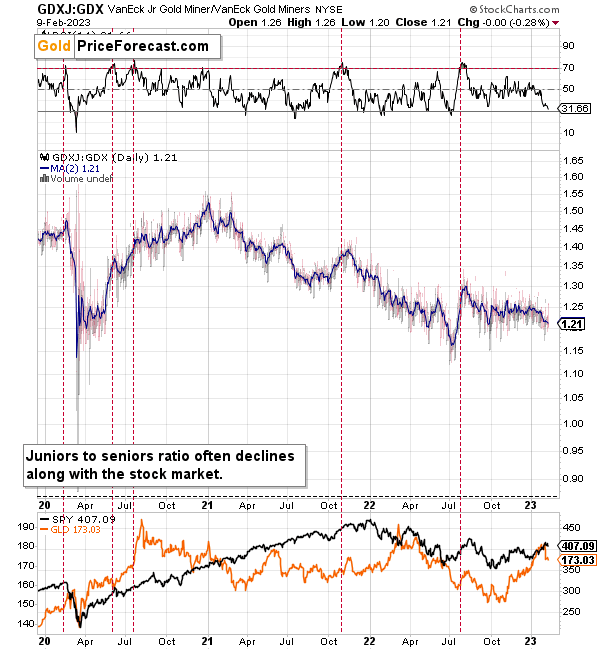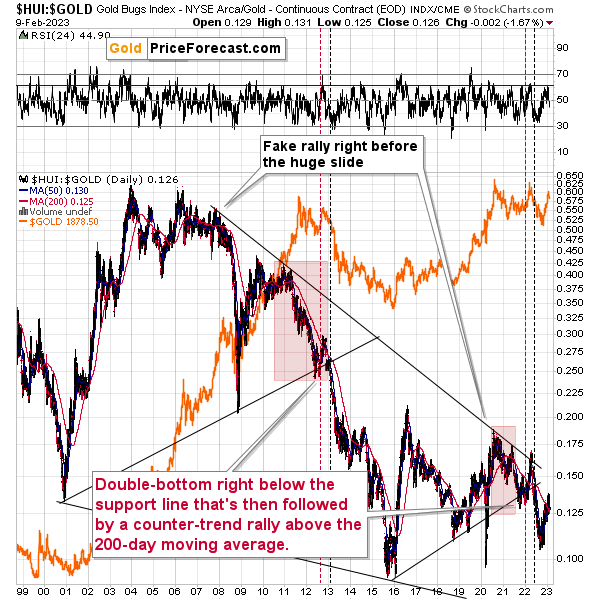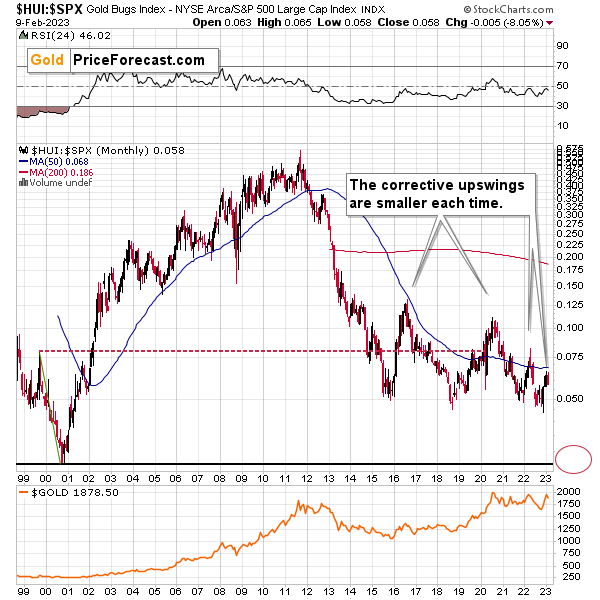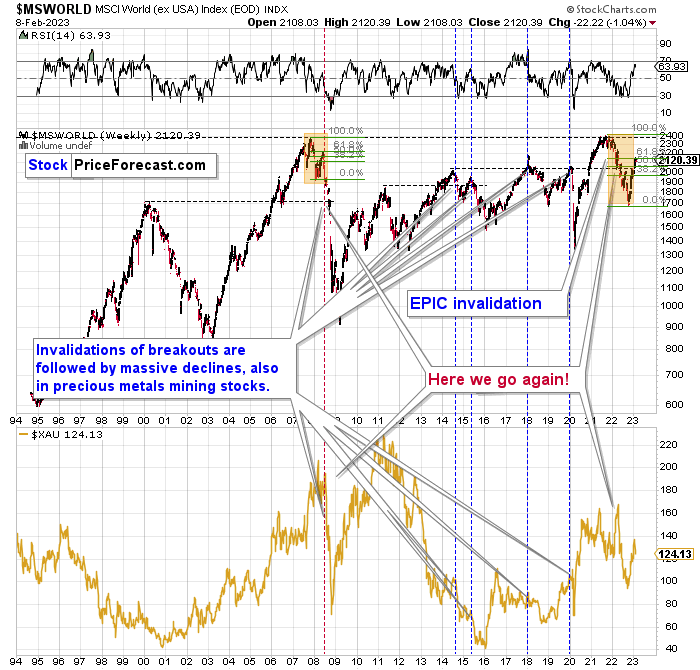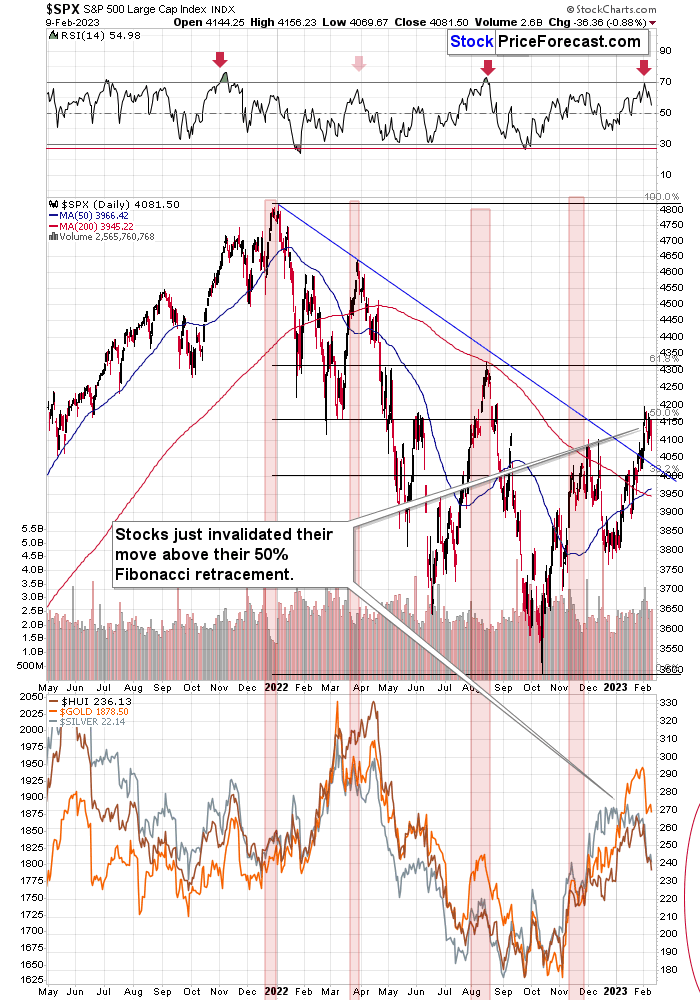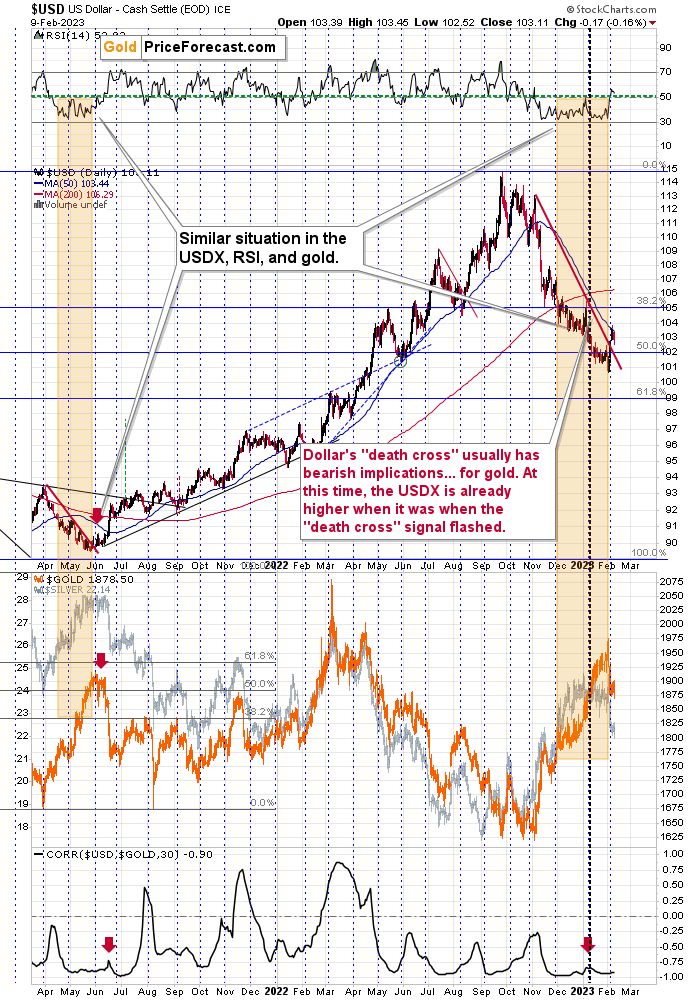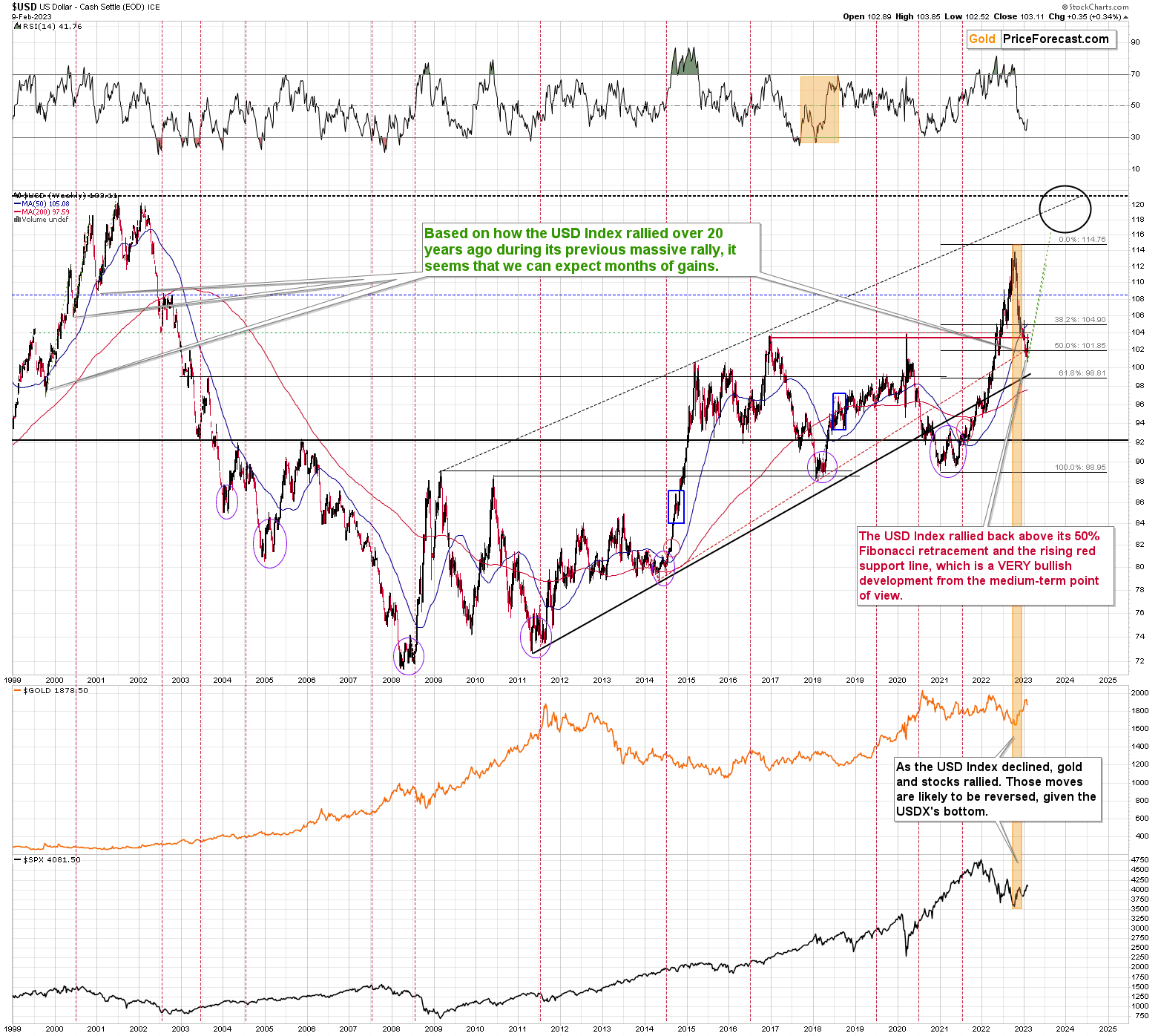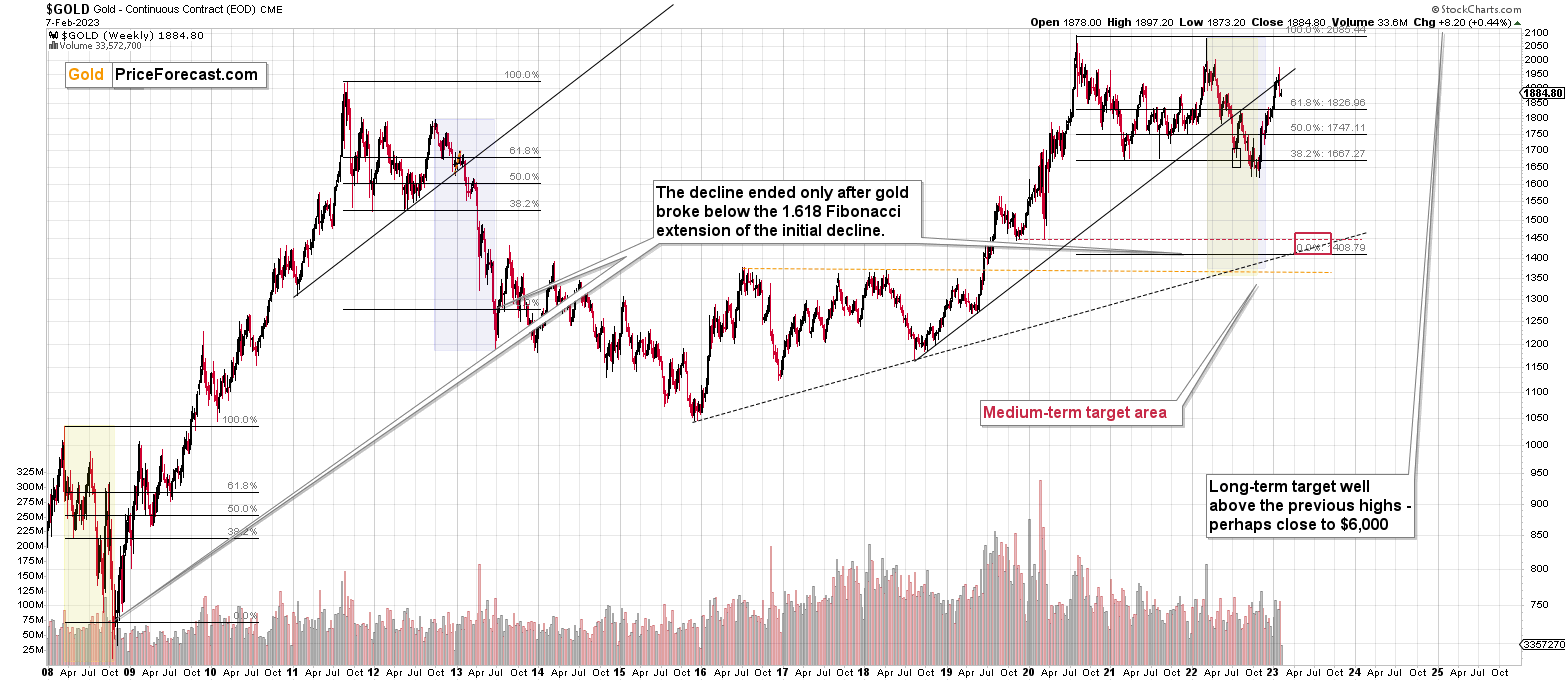Briefly: gold and the rest of the precious metals market are likely to decline in the next several weeks/months and then start another powerful rally. Gold’s strong bullish reversal/rally despite the USD Index’s continuous strength will likely be the signal confirming that the bottom is in.
Welcome to this week's Gold Investment Update. Our most recently featured medium-term outlook remains the same as the price moves align with our expectations (or at least are not really against them). On that account, there are parts of the previous analysis that didn’t change at all in the earlier days and are written in italics.
The key thing that is still happening this week is the continuation of the slide in the precious metals market (in particular, in the junior mining stocks) as well as the continuation of the move higher in the USD Index.
Also, I’ll keep the previous “Technical Look at the Fundamentals” section intact, because it remains to have the key background impact on the entire landscape for all markets, including the precious metals market. After all, one of the two primary fundamental drivers of gold prices (the other being the USD Index) is real interest rates. In fact, that’s what I’m going to start with. (This section is just as it was previously, so if you have already read it, please feel free to scroll down to the next section.)
Technical Look at Fundamentals
Let me start by quoting one of the things that we already wrote above:
However, we’ve warned on numerous occasions that the Fed has always pushed the U.S. federal funds rate (FFR) above the peak year-over-year (YoY) percentage change in the core Consumer Price Index (CPI), and that nine of the last 10 bouts of rising inflation have ended with recessions.
The latter – likelihood of a recession – means that the stock market (along with silver, mining stocks, and – in particular – junior mining stocks) is likely to fall. Given how far it rose on the various stimulus-based programs, it can also fall substantially. This is not to be taken lightly.
The former implies that either higher rates or lower inflation, or both, are possible. Or at least a faster increase in rates than in inflation (or a slower decline in rates than in inflation).
In fact, let’s see the long-term chart once again.
Here’s what gold did in the long run.
The above chart features gold prices in nominal terms, and the below chart shows the price of gold in real terms (adjusted for inflation based on the official inflation statistics).
Source: Macrotrends.net
The thing that I want to emphasize here is gold’s performance in the 70s and 80s. There were two major declines in gold – one started in mid-70s and another in 1980. Let’s zoom in a bit on the former, as it might not be clear based on the above charts.
Source: chartsrus.com
What happened on the rates vs. CPI chart at those times? There were some major shifts in their relative values.
To make it easier to see what was going on, let’s take a look at yet another chart – the one featuring both nominal and real Treasury yields. Of course, the yields are closely linked to the interest rates, so it’s pretty much the same chart.
The real yield is what is of the greatest importance here.
Why? Because that is what one effectively gets by postponing consumption, saving the capital, and investing (technically, lending) it at very low risk.
If the real yield moves below 0%, it means that one is effectively losing money while just earning interest on Treasuries. That is when gold becomes extremely valuable. Gold pays no interest, but it’s been currency throughout history, so it’s viewed as something safe and stable in the long run. Therefore, it seems better to just hold gold, which at least won’t (theoretically) lose value, while fiat money does. In other words, gold is then used as an inflation hedge.
When the real yields rally, however, the situation turns upside down.
Since gold doesn’t provide interest, and rising real yields mean that it makes more and more sense to have capital in the form of money that pays this increasing interest (like Treasuries), the appeal for gold ownership declines.
That’s why real yields and real interest rates are one of the two key fundamental drivers of gold prices. The other is the USD Index.
Indeed, the lows in real yields (mid-70s and 1980) corresponded to tops in the gold price.
So, again, to clarify:
- Rising real interest rates / yields are extremely likely to trigger declines in the gold price.
- Declining real interest rates / yields are extremely likely to trigger rallies in the gold price.
The above might not work in the short term, but it’s likely to work over the medium and long term. After all, the markets can be particularly emotional in the short run and move on just about anything, regardless of whether it makes sense or not.
All right, to clarify even more, what exactly are those real interest rates? How to calculate them?
Here’s the definition from Google / Wikipedia.
Nominal interest rate minus the (expected) inflation rate. This approximation will suffice.
Where are the nominal interest rates going now? Higher. They may be rising at a slower rate than previously, but they are rising, and, as history has shown, they will continue to rise until the federal funds rate rises above the year-over-year CPI reading..
The latest year-over-year CPI reading in the U.S. (from Jan. 12, 2023) was 6.5%.
The FFR is about 2% below that.
The above and the historical tendencies imply that either the CPI has to move lower by at least 2% or the FFR has to move higher by 2% while the CPI is unchanged – or some combination of the above (which is most likely).
Either way, this means that the real interest rate is likely to rally by at least 2% from its current levels.
Let me quote what I already stated above:
Rising real interest rates / yields are extremely likely to trigger declines in the gold price.
This means that we are extremely likely to see big declines in the gold price.
What are the real rates doing now?
Well, they are soaring, of course. However, as I wrote earlier, the link between real rates and the gold price doesn’t have to work in the short term, as the markets can focus on all sorts of things due to technical/emotional reasons.
I won’t say that the current rally in real rates is unprecedented, but we haven’t seen this kind of upswing in a long time. The last time we saw something of at least similar magnitude was right before the year 2000. What happened to the gold price back then?
Gold was after the “Brown Bottom,” but it declined, nonetheless.
In the case of the HUI Index – proxy for gold stocks – it was right before the final part of the slide.
Yes, this is as extremely bearish as it looks.
These are some of the reasons why this short-term rally is a counter-trend rally. The things that I’m covering in my day-to-day analyses are important too, but they are not as important as the above indications. I’m simply not commenting on the things that don’t change that often, but the day-to-day price swings do change often, and I’m commenting on them because they often make people concerned about the outlook.
Speaking of a more short-term situation, let’s take a look at what happened and what changed (and what didn’t change) more recently.
Technically Speaking
Let’s start today’s technical discussion with a quick check of copper prices.
Copper rallied recently, but it stopped at its 61.8% Fibonacci retracement level and then moved back down. Consequently, the recent move – while impressive from the day-to-day point of view – remains to be a short-term correction only.
Consequently, what I wrote about it previously remains up-to-date:
Copper recently CLEARLY invalidated another attempt to move above its 2011 high. This is a very strong technical sign that copper (one of the most popular commodities) is heading lower in the medium term.
No market moves up or down in a straight line (well, the 2008 slide appears to have been an exception), and a short-term correction doesn’t necessarily invalidate the bigger trend. For the last couple of months, copper has been trading sideways, but it didn’t change much regarding the outlook.
In fact, it made my previous target area even more likely. You see, the consolidation patterns are often followed by a move that’s similar to the move that preceded them. In this case, the previous 2022 decline was quite significant, and if it is repeated, one can expect copper to decline well below 3.
Actually, copper could decline profoundly and bottom in the $2.0-2.7 area. That’s where we have rising, long-term support lines and also the previous – 2016 and 2020 – lows.
Flag patterns (which we just saw in copper) tend to be followed by price moves that are similar to ones that preceded them. I marked this on the above chart with red, dashed lines. This method supports a copper price’s move to around $2.7.
Given the size of the previous decline (and its pace), it seems quite likely that it could take another 2-7 months for copper to move to about $2.4. May seems to be the most likely time target given the current data.
Interest rates are going up, just like they did before the 2008 slide. What did copper do before the 2008 slide? It failed to break above the previous (2006) high, and it was the failure of the second attempt to break higher that triggered the powerful decline. What happened then? Gold declined, but silver and mining stocks truly plunged.
Again, copper is after invalidation of a major breakout, a decline, and a correction. Copper prices currently SCREAM that it’s a variation of 2008 all over again. This is extremely bearish for mining stocks (especially juniors) and silver.
Having said that, let’s check junior miners’ really big picture.
In short, we saw a tiny correction in the TSX Venture index, and this should be a major red flag for anyone thinking that the recent rally was a game- or trend-changer. This is a blip on the radar screen, similar to what we saw in the second half of 2021, before another big move lower.
Consequently, my previous comments on the above chart remain up-to-date:
The Toronto Stock Exchange Venture Index includes multiple junior mining stocks. It also includes other companies, but juniors are a large part of it, and they truly plunged in 2008.
In fact, they plunged in a major way after breaking below their medium-term support lines and after an initial corrective upswing. Guess what – this index is after a major medium-term breakdown and a short-term corrective upswing. It’s likely ready to fall – and to fall hard.
So, what’s likely to happen? We’re about to see a huge slide, even if we don’t see it within the next few days.
Just like it was the case in 2008, the move higher that we saw before the final (biggest) slide in gold, silver, and gold stocks (lower part of the chart), we didn’t see a visible rally in the TSX Venture Index. Just as the index paused back then, it paused right now.
Currently, it’s trading at about 600, and back then, it consolidated at about 2500. The price levels are different, but the overall shape of the price moves (lack thereof) is similar. This serves as a signal, that the recent upswing in the PMs was not to be trusted.
The above is one of the weakest (from the technical point of view) charts that is see across the board right now. There is a strong long-term downtrend visible in the TSX Venture Index, and if stocks slide similarly as they did in 2008, the TSXV could truly plunge – perhaps even to the 300 level or lower.
The important short-term detail is that the TSXV just broke to new yearly lows. This is a major (yet barely noticed by most) indication that the next big move lower is about to start.
Having said that, let’s turn to gold.
Let’s start with context:
Between 2020 and now, quite a lot happened, quite a lot of money was printed, and we saw a war breaking out in Europe. Yet gold failed to rally to new highs.
In fact, gold is once again trading well below its 2011 high, which tells you a lot about the strength of this market. It’s almost absent.
There’s a war in Europe, and billions of dollars were printed, and gold is below its 2011 highs – in nominal terms! Adjusted for inflation, it’s much lower. And silver and gold stocks’ performance compared to their 2011 highs? Come on…
Truth be told, what we see in gold is quite in tune with what we saw after the 2011 top, and in particular, shortly after the 2012 top. We can also spot similarities between now and 2008. The long-term gold price chart below provides details.
As I wrote a bit earlier, the key thing is that gold once again tried to move above its 2011 highs, but it once again failed to do so. It invalidated this breakout in one of the most bearish ways imaginable – with a weekly reversal.
This is an extremely important sell signal. I’m describing quite a few of those today, but this combination of fundamental and technical factors alone is a reason to prevent one from having a long position in gold right now (except for the insurance capital, that is).
That’s one thing. Another thing is that, given the major fundamental event that I already mentioned above (the war outbreak), it’s possible for the technical patterns to be prolonged and perhaps even repeated before the key consequence materialized. Similarly to the head-and-shoulders pattern that can have more than one right head, before the breakdown and slide happen.
In gold’s case, this could mean that due to the post-invasion top, the entire 2011-2013-like pattern got two major highs instead of one. Thus, the initial decline and the subsequent correction are pretty much a repeat of what we saw in 2020 and early 2021, as well as what we saw in 2011 and 2012.
The particularly interesting fact (!) about the correction that we saw after the 2011-2012 decline (the one that was followed by the huge 2012-2013 decline) is that during it, gold corrected slightly more than 61.8% of the preceding medium-term decline. Consequently, the current situation is just like what happened back then.
If all the above wasn’t bearish enough, please take a look at the reading of the RSI indicator based on the weekly price changes. It’s now just below 70, and guess where it was at the final top before the 2012-2013 slide? Yes, it was exactly there, too.
That’s also approximately where the RSI was at last year’s top.
The orange rectangles on the above chart represent the corrective upswings from approximately the previous local lows. There are two of them, and back in 2013, there was just one corrective upswing before gold truly plunged.
However, please remember that history doesn’t repeat itself to the letter – it rhymes. This means that two corrections instead of one are still within the scope of the similarity, especially since the first correction wasn’t as big as the 2008 one.
The current situation is truly special, as the rate hikes are something that we haven’t seen in a long time. The same goes for the level of concern about the inflation that’s “out there.” The latter implies that when faced with a decision about whether to fight inflation or help the economy, the Fed is likely to lean toward the former. That’s bearish for assets like gold.
Looking at gold from a short-term point of view, we see that it has indeed moved above the 61.8% Fibonacci retracement.
When the above happened, but before the invalidation of the move, I wrote that this would have been a bullish indication if it weren’t for the very bearish analogy to late 2012.
Particularly given that gold's RSI based on weekly closing prices is just below 70 and the RSI based on daily prices is well above 70. In fact, gold’s daily RSI is above 70 for the second time in a relatively short period, and that’s exactly what we also saw at the 2022 top.
What happened next? Gold pierced through its rising support line (on huge volume that confirmed the move!) and it invalidated the move above the 61.8% Fibonacci retracement.
History rhymed. And the next verse in that poem is very bearish.
Remember the feeling that was prevalent among gold investors and traders at the 2022 top, when it was trading above $2,000? The overwhelming bullishness? The feeling of invincibility? All the theories due to which gold just has to rally? It’s been quite similar recently.
These are emotions that accompany tops, whereas fear, disappointment, and despair accompany bottoms. It’s much easier to describe ignoring emotions in trading than to actually do it, but it’s my responsibility to remind you how it is, how it was, and what happened to the price of gold during similar times.
And it fell. Hard.
What does it tell you about the likely medium-term (next several months) future for the yellow metal?
That it doesn’t look good.
What could look good – in fact, amazing – is the result of being correctly positioned within this decline. Not all parts of the precious metals sector provide the same risk to reward opportunity, and there are counter-trend moves that provide extra opportunities. Investing in insights might be the best investment that one actually makes in this situation.
Having said that, let’s take a closer look at the silver market.
For some time, silver’s chart was very boring. It did nothing for weeks. Precisely, it kept trying to break above its 61.8% Fibonacci retracement level, and then it invalidated that break.
Then it happened.
Silver plunged not only below its 61.8% Fibonacci retracement but also below the 50% one!
That happened just days after it tried to move to new yearly highs, which is… Not surprising at all, at least to those who have been following my analyses for some time and are well aware of how volatile the silver market can be.
The thing is that silver is known (at least to those with expertise in this market) for its fake breakouts and fake strength relative to gold. In fact, this is so common that looking at the silver-to-gold ratio for exceptional short-term strength is one of the most useful sell signals in the precious metals sector!
With silver now trading not only below the above-mentioned retracements, but also its mid-November high, the outlook is clearly very bearish.
Let’s take a look at the situation from a broader point of view.
When looking at silver from a long-term point of view, it’s still obvious that the recent move higher was most likely just a corrective upswing.
What happens after corrections are over (as indicated by, i.e., silver’s outperformance)? The previous trend resumes. The previous trend was down, so that’s where silver is likely headed next.
Besides, the long-term turning point for silver is due in several months, and if silver repeats its previous 2022 decline, then it will bottom close to the turning point and also close to the $15 level– in the first half of 2023.
It’s likely to repeat its previous 2022, because that’s what tends to happen after flag patterns, and what you see on silver’s short-term chart between September and yesterday appears to be a flag pattern.
However, will silver only repeat its previous 2022 performance and not decline more than it already has?
Based on the analogies to 2008 and 2013, the latter is more likely. The 2013 slide was bigger than the initial decline that we saw in 2012. And the final 2008 slide was WAY bigger than what we saw before it.
Due to its industrial uses, silver is known to move more than gold, in particular when the stock market is moving in the same way as gold does. Since I think that gold and stocks are both likely to slide, silver is indeed likely to decline in a truly profound manner. Quite likely lower than just $15.
Consequently, my prediction for silver prices remains bearish, as does the outlook for the rest of the precious metals sector.
Let’s not forget that rising interest rates are likely to negatively impact not just commodities, but practically all industries. This will likely cause silver’s price to decline profoundly, as silver’s industrial demand could be negatively impacted by lower economic growth (or a decline in economic activity).
Consequently, it seems that silver will need to decline profoundly before it rallies (to new all-time highs) once again.
Having said that, let’s take a look at what happened in mining stocks.
History tends to repeat itself. Not to the letter, but in general. The reason is that while economic circumstances change and technology advances, the decisions to buy and sell are still mostly based on two key emotions: fear and greed. They don’t change, and once similar things happen, people’s emotions emerge in similar ways, thus making specific historical events repeat themselves to a certain extent.
For example, right now, gold stocks are declining similarly to how they did in 2008 and in 2012-2013.
Moreover, the Stochastic indicator (lower part of the above chart) is currently performing just like it did at the 2022 top – so, the bearish similarity between those periods is not just in gold.
However, what I would like you to focus on here is that the “double correction” theory that I described below gold’s long-term chart is clearly visible also here. We already saw the 2012 rally being repeated and now we see it all over again. I marked them with red ellipses.
What are the implications? Well, obviously they are bearish, as it was this correction in 2012 that started one of the most powerful declines of the previous decades. The RSI indicator based on the weekly prices is in a similar position to where it was at the late-2012 and 2022 tops. The consequences are clearly bearish for the following months.
My previous comments on the above chart, therefore, remain up-to-date:
The situation being what it is on the gold market (as discussed above) and the stock market (as I’ll discuss below), it seems to be only a matter of time before gold stocks slide.
For many months, I’ve been writing that the situation in the HUI Index is analogous to what we saw in 2008 and in 2013. Those declines were somewhat similar, yet different, and what we see now is indeed somewhere in between of those declines – in terms of the shape of the decline.
At first, the HUI Index declined just like it did in 2013, and the early-2022 rally appears to be similar to the late-2012 rally. However, the correction that we saw recently is also similar to the late-2012 rally.
Since the history doesn’t repeat itself to the letter, but it rhymes, is it that odd that we now saw two corrective upswings instead of one? Not necessarily.
This is especially the case that the 2008 decline had one sizable correction during the big decline. It’s not clearly visible on the above chart due to the pace of the 2008 slide, but it’s definitely there. You can see it more clearly in one of the below charts.
So, no, the recent rally is not an invalidation of the analogies to the previous patterns, it continues to rhyme with them in its own way. And the extremely bearish implications for the following months remain intact.
How low can the HUI Index fall during the next big downswing?
As it’s the case with gold and silver, a move back to the 2020 lows is definitely in the cards. Please note that this level is also strengthened (as support) by other major lows: the 2019, 2014, and 2008 ones.
However, I wouldn’t rule out a move even lower on a temporary basis. If gold were to decline to about $1,450-1,500, it would mean that it would double its current 2022 decline. If the HUI Index does that, it will move below 150.
So, all in all, 100-150 is my current target area for the upcoming slide in the HUI Index.
What about the short run?
Let’s start with what I wrote about two weeks ago:
Junior miners moved above their 50% Fibonacci retracement based on the 2022 decline but the GDXJ ETF did not move to their 61.8% Fibonacci retracement.
- Well, so? What’s so special about it?
Everything!
That’s exactly how high this junior miners ETF corrected in mid-2021 and in 2022 before the decline continued. And the slide was bigger in the second case. That’s interesting, as it could be the case that since the correction is now based on a bigger decline, then the follow-up plunge will be – once again – bigger as well.
Getting back to the original observation, the two declines that were corrected in the above-mentioned way started at the same top – the 2020 high.
The first correction that I marked with red Fibonacci retracement levels started from the early-2021 bottom.
Gold stocks corrected more than half of the decline (not more than 61.8% thereof), the RSI moved close to 70, and there was a final, irrational pop-up in prices. And that was the top. I marked it with an orange rectangle.
The second correction that I marked with blue Fibonacci retracement levels started from the early-2022 bottom.
Gold stocks corrected more than half of the decline (not more than 61.8% thereof), the RSI moved close to 70, and there was a final, irrational pop-up in prices. And that was the (2022) top. I marked it with a red rectangle.
And what do we see now? The decline that is being corrected started in 2022 and the corrective upswing started in the final part of 2022.
Gold stocks corrected more than half of the decline (not more than 61.8% thereof), the RSI moved close to 70, and there was a final, irrational pop-up in prices. I copied both above-mentioned rectangles to the current situation and its obvious that there’s also a similarity in terms of indicators.
In case of the first analogy, the similarity is in the RSI indicator (upper part of the chart), and in case of the second analogy, the similarity is in the MACD indicator (lower part of the chart).
Also, please note that the 50-day moving average just moved above the 200-day moving average, which means that a “golden cross” formed. This is a supposedly bullish indication, but history doesn’t confirm this description. In fact, the last time we saw it, was in early 2022, close to the yearly top. Consequently, it’s not a bullish indication right now.
After I posted the above bearish warning, it didn’t take long for the mining stocks to decline profoundly. Today’s intraday low was $35.51 and the GDXJ closed the previous year at $35.65, so for a moment (we saw a tiny correction since that time), 2023 was a “down” year for junior mining stocks!
As the bearish indications continue, the question becomes: when will the next short-term bottom be?
As you’ve already read, I expect the medium-term decline to take the mining stocks much lower. However, just because something is likely to happen, doesn’t mean that it’s likely to happen immediately or without periodic corrections.
In the case of the junior mining stocks, the next short-term (!) downside target is between $32.5 and $34 The upper border of this target area, in particular, appears to be quite strong short-term support, which could trigger a very short-term rebound.
Why would this be the case? For example, due to the similarity between what happened after the previous similar tops and the following price declines.
In the past, the GDXJ paused after reaching the previous bottoms, and once it corrected half or slightly more of the previous rally. In the most recent case – in April 2023 – that happened from levels that were slightly below the 200-moving average.
All the above points to the above-mentioned target area. That’s where we have the previous lows and where we have the 50% Fibonacci retracement.
That’s also where we have the rising support line based on the September and November lows that you can see more clearly on the above chart.
Whether one wants to trade the possible corrective upswing or not is a different matter, but it does indeed seem likely that we might see some correction from those levels. Please note that the decision to take advantage of the corrective upswing vs. the decision to wait it out while focusing on the big, medium-term downswing is highly individual. As is the case with pretty much everything, it’s best to keep oneself in mind: one’s risk tolerance, goals and motivations for them, time that one can dedicate to monitoring the situation, and so on.
Also, please note that the above chart also shows just how perfectly the recent price moves played out according to the Elliott Wave Theory.
Of course, EWT is not the only tool that one could use, and I find other technical tools more useful, but still, this kind of pattern-following is uncanny.
The classic EWT pattern is three waves down (I marked those with orange rectangles) and then a correction consisting of two smaller waves.
That’s exactly what we have seen in recent months. The September–now pattern appears to be the above-mentioned correction.
Meanwhile, the relative performance of junior miners compared to senior miners continues to deteriorate in a medium-term trend.
During this quick upswing, juniors rallied relative to seniors, but this is just a very short-term move that’s within a short- and medium-term downtrend.
This implies bigger declines in the GDXJ in the future.
Also, let’s not forget about the forest while looking at individual trees. By that, I mean looking at how gold stocks perform relative to gold. That’s one of the major indications that the current situation is just like what we saw at the 2012 top.
The situation in the gold stock to gold ratio is similar to what we saw in late 2012 and early 2013. The HUI to gold ratio invalidated its first attempt to break lower (marked with red, dashed lines), but after a corrective upswing, it then broke lower more decisively. That’s what I marked using black, dashed lines.
Recently, we saw a quick upswing in the ratio, but that’s not a game-changer – even the biggest declines had corrections in the past.
If history is to rhyme, we’re about to see a profound decline. In fact, we’re likely already past its beginning.
Also, please note that the pattern that we currently see, which started in early 2016, is somewhat similar to what happened between 2003 and 2008.
Back in 2008, the breakdown from the consolidation resulted in sharply lower ratio values and much lower prices of gold stocks.
So, if the situation is analogous to 2012-2013, we’re likely to see a big decline in the following weeks/months, and if it’s analogous to 2008, we’re likely to see an enormous decline in the following weeks/months.
Interestingly, the situation in the gold stocks to other stocks ratio (HUI Index vs. S&P 500 Index) provides the same implications but from a different angle.
The corrective upswings that we’ve been seeing since 2015 are getting smaller and smaller. The current one is visibly smaller than what we saw last year.
Consequently, it seems that the ratio is ripe for a breakdown below the 0.05 level. The next support is provided by the all-time low at 0.026. And yes, with the ratio at 0.065 right now, this implies a decline by about 60%. If the HUI Index were to decline by 60% right now, it would have to move to about 100. If the stock market declined as well, it would imply the HUI was even lower.
Declining stock prices would only add fuel to the bearish fire (after all, gold stocks are… just stocks) and that’s exactly what’s likely to happen.
Just like what we saw in the case of copper and gold, world stocks corrected about 61.8% of their preceding decline. Given the resemblance to 2008, this is extremely bearish.
Please note that the initial decline is now bigger than what we saw in 2008. Back then, stocks corrected about 61.8% of their initial decline before tumbling. And exactly the same thing happened recently!
Just as the 2008 rally wasn’t bullish, the most recent corrective upswing wasn’t bullish at all.
The real interest rates are going higher, which is very bad for businesses! People appear to live on “hopium,” expecting the Fed to turn dovish and throw money on the market, but the data doesn’t support this outcome at all.
Given the analogy to 2008, and the fact that the initial slide was bigger this time, the following slide could be even bigger than what we saw in 2008. Naturally, this would be profoundly bearish for junior mining stocks.
This means that nothing really changed, and the situation remains extremely bearish based, i.e., on the analogy to what we saw after previous invalidations of long-term breakouts.
As a reminder, in early 2022, I wrote that the situation was very bearish as invalidations of previous breakouts were usually followed by massive declines – not just in stocks but also in precious metals.
When stocks invalidated their 2006 breakout in 2008, their prices truly crumbled.
We also saw that on a smaller scale in 2014, 2015, and early 2018.
We’re seeing it right now.
To clarify, we’re actually seeing the aftermath of the invalidation. The huge decline is already taking place.
The difference between now and 2008 is that back then the slide was more volatile, and we didn’t really see a visible correction during the plunge. This time, the decline is more measured, and we saw a correction to one of the most classic retracements imaginable – the 38.2% one. This correction doesn’t change the trend, which remains down.
Based on what happened in 2008, it seems that stocks are about to move much lower in the following months.
Let’s take a look at the markets from a more short-term point of view and from the U.S. perspective.
In short, stocks just invalidated their move above their 50% Fibonacci retracement, which was a profoundly bearish event.
The move above the declining blue support/resistance lines wasn’t invalidated, but given the above and the fact that the RSI indicator (upper part of the above chart) did what it used to do at the previous major tops (including the mid-2022 top), it’s likely that we’re going to see an invalidation of this breakout shortly.
In fact, given what we saw on the chart featuring world stocks, the above seems very likely.
Why is this important for gold and silver investors and traders? Because the last two big moves took place more or less in line with each other – in stocks and in precious metals (and miners). The slide in stocks could also trigger something similar in the case of commodities like crude oil. The same thing is likely to happen again this time, especially given what’s happening in the USD Index.
Namely, the USD Index appears to have bottomed approximately at its 50% Fibonacci retracement.
After moving slightly below this level, the USD Index soared, it formed a weekly bullish (“hammer”) candlestick, and it even verified the breakout above the declining red resistance line.
The tiny pullback after the breakout didn’t result in sizable declines, which means that the breakout was confirmed. This has bullish implications for the following days and weeks for the USDX and it has bearish implications for the precious metals sector.
While it might not be visible clearly enough on the above chart, it’s true that the USD Index moved back above its 2016 high.
This is critical (and not the 2020 high), because the 2020 high was just a brief attempt to move above the well-established 2016 highs. So, it is the fact that we saw a move back above those that matters, not the fact that the USDX is still trading below the 2020 high.
The above chart shows that the USD Index additionally resisted the pressure to move below the rising red, dashed support line. This means that it showed strength (in one additional way). The implications are very, very bullish for the following weeks.
All in all, the USD Index appears to be bottoming here, and the precious metals sector appears to be topping.
Overview of the Upcoming Part of the Decline
- It seems to me that the corrective upswing is over (or about to be over) and that the next big move lower is already underway (or that it’s about to start).
- If we see a situation where miners slide in a meaningful and volatile way while silver doesn’t (it just declines moderately), I plan to – once again – switch from short positions in miners to short positions in silver. At this time, it’s too early to say at what price levels this could take place and if we get this kind of opportunity at all – perhaps with gold prices close to $1,500 - $1,550.
- I plan to switch from the short positions in junior mining stocks or silver (whichever I’ll have at that moment) to long positions in junior mining stocks when gold / mining stocks move to their 2020 lows (approximately). While I’m probably not going to write about it at this stage yet, this is when some investors might consider getting back in with their long-term investing capital (or perhaps 1/3 or 1/2 thereof).
- I plan to return to short positions in junior mining stocks after a rebound – and the rebound could take gold from about $1,450 to about $1,550, and it could take the GDXJ from about $20 to about $24. In other words, I’m currently planning to go long when GDXJ is close to $20 (which might take place when gold is close to $1,450), and I’m planning to exit this long position and re-enter the short position once we see a corrective rally to $24 in the GDXJ (which might take place when gold is close to $1,550).
- I plan to exit all remaining short positions once gold shows substantial strength relative to the USD Index while the latter is still rallying. This may be the case with gold prices close to $1,400 and GDXJ close to $15 . This moment (when gold performs very strongly against the rallying USD and miners are strong relative to gold after its substantial decline) is likely to be the best entry point for long-term investments, in my view. This can also happen with gold close to $1,400, but at the moment it’s too early to say with certainty.
- The above is based on the information available today, and it might change in the following days/weeks.
You will find my general overview of the outlook for gold on the chart below:
Please note that the above timing details are relatively broad and “for general overview only” – so that you know more or less what I think and how volatile I think the moves are likely to be – on an approximate basis. These time targets are not binding nor clear enough for me to think that they should be used for purchasing options, warrants, or similar instruments.
Letters to the Editor
I received a few messages in our e-mail inbox, but I will copy-paste them to the comments feed below my premium articles (as a reminder, the “Gold Trading Alert” space on Golden Meadow is reserved to subscribers – it’s not accessible publicly) along with my replies.
Please post your questions in the comments feed below the articles, if they are about issues raised within the article (or in the recent issues), and if they are about other, more universal matters, I encourage you to use the Ask the Community space (I’m also part of the community, after all), so that more people can contribute to the reply and then enjoy the answer. Of course, let’s keep the target-related discussions in the Gold Trading Alerts space.
Summary
To summarize, in my view, the real interest rates are up and about to soar higher, the USD Index most likely bottomed and is likely to soar, while the precious metals topped in a spectacular manner and are now likely to slide – either shortly or soon enough. The rally in gold, silver, and miners was indeed sizable, but… it’s over.
What’s next? Something exciting (and, in my view, very lucrative) or something scary – depending on how positioned and informed one chooses to be.
Also, please note that (paraphrasing Sun Tzu) “understanding the enemy without understanding your true self is only half of a victory.” Before applying any insights into actionable practice (and placing or adding to your trades), please make sure that the position that you’re about to enter and its size are aligned with your approach, your investment goals, and your risk tolerance.
In other words, I suggest starting with yourself and tailoring the trade to you, not the other way around. Please consider your motivation for this trade and how it aligns with the rest of your approach and life in general.
Hint: don’t go for the easy answer like “money” or “profits,” but consider why the result of the trade is important – is this a part of your well-designed strategy and “you have it,” or is it something you “must absolutely do” – in other words, “it has you”…)
This will save you lots of stress, which is not only end in and of itself (your happiness and health are both closely linked to your stress levels), but it also helps you become a more profitable investor as less stress (or none thereof) means more objectivity and less risk of “running for the hills” right before a given trade becomes profitable (perhaps extremely so).
Given the above, gold’s invalidation of the temporary move above its very long-term resistance (the 2011 high!), and the situation in the USD Index, it seems that the next big move lower in the precious metals sector is already underway.
Now, as more investors realize that interest rates will have to rise sooner than expected, the prices of precious metals and mining stocks (as well as other stocks) are likely to fall. In my opinion, the current trading position is going to become profitable in the following weeks, and quite possibly in the following days. While I can’t promise any kind of performance, I fully expect it to become very profitable before it’s over and to prolong our 2022 winning streak.
After the final sell-off (that takes gold to about $1,350-$1,500), I expect the precious metals to rally significantly. The final part of the decline might take as little as 1-5 weeks, so it's important to stay alert to any changes.
As always, we'll keep you – our subscribers – informed.
To summarize:
Short-term outlook for the precious metals sector (our opinion on the next 1-6 weeks): Bearish
Medium-term outlook for the precious metals sector (our opinion for the period between 1.5 and 6 months): Bearish initially, then possibly Bullish
Long-term outlook for the precious metals sector (our opinion for the period between 6 and 24 months from now): Bullish
Very long-term outlook for the precious metals sector (our opinion for the period starting 2 years from now): Bullish
As a reminder, Gold Investment Updates are posted approximately once per week. We are usually posting them on Friday, but we can’t promise that it will be the case each week.
Our preferred ways to invest in and to trade gold along with the reasoning can be found in the how to buy gold section. Additionally, our preferred ETFs and ETNs can be found in our Gold & Silver ETF Ranking.
Moreover, Gold & Silver Trading Alerts are posted before or on each trading day (we usually post them before the opening bell, but we don’t promise doing that each day). If there’s anything urgent, we will send you an additional small alert before posting the main one.
Thank you.
Przemyslaw K. Radomski, CFA
Founder, Editor-in-chief


